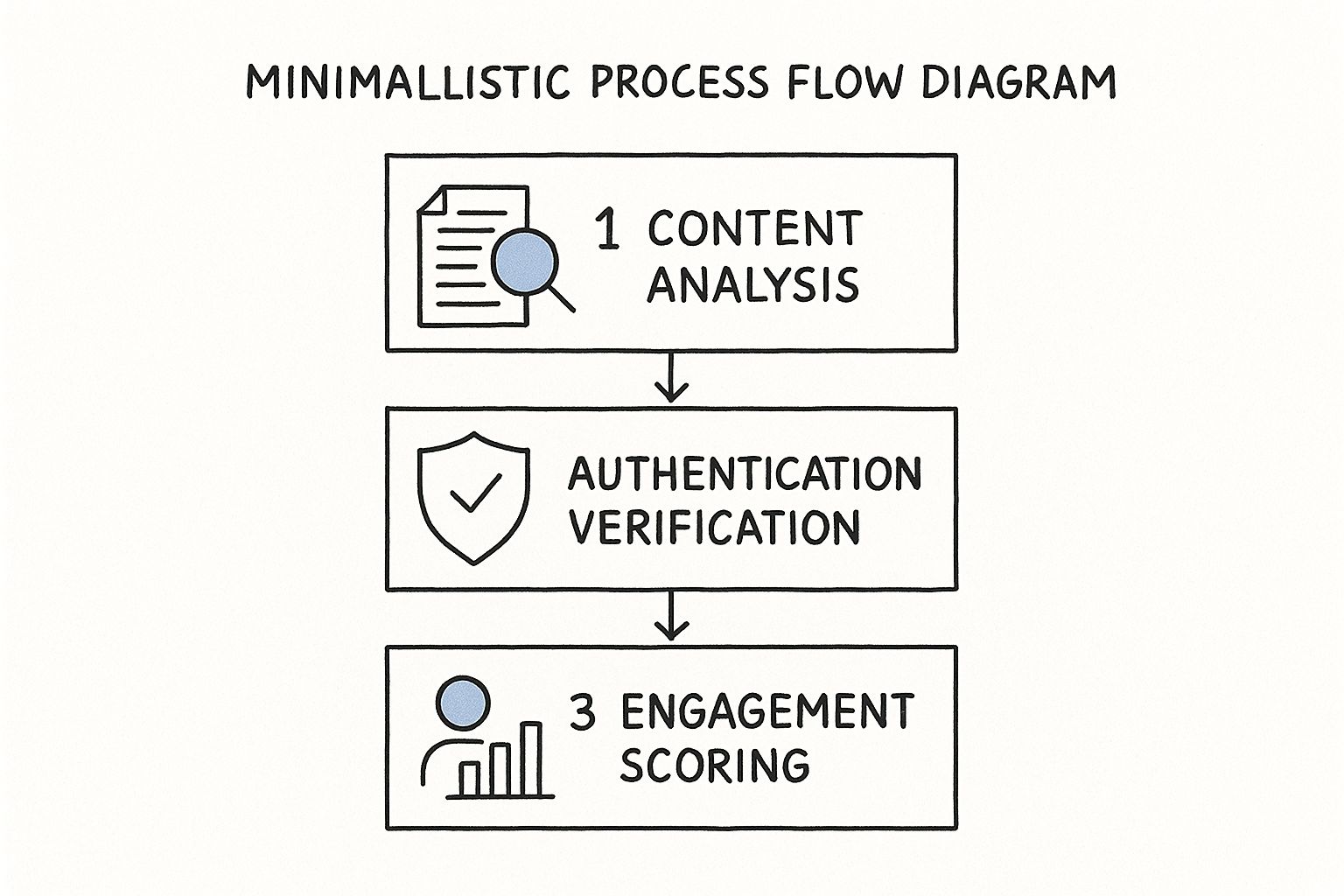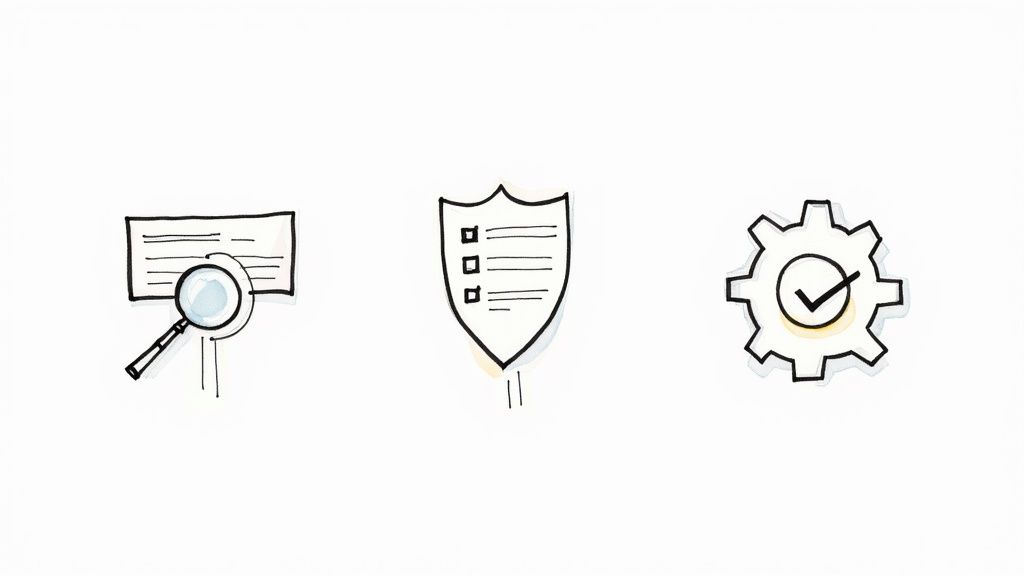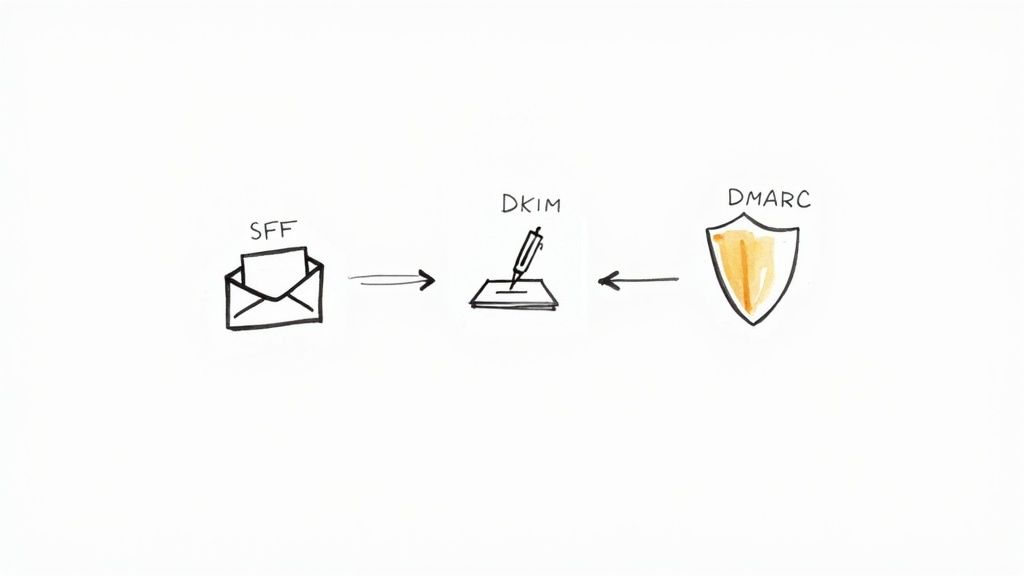Before you even think about writing your first subject line, your chances of landing in the inbox are already being decided. Why? Because your domain's technical health is the first thing inbox providers like Google and Microsoft scrutinize.
Think of it like building a house. You wouldn't put up walls and a roof on a shaky foundation, right? In the world of email, that rock-solid foundation is built with a trio of authentication protocols: SPF, DKIM, and DMARC.
These aren't just technical acronyms to check off a list. They are your domain's official credentials, and they answer one simple but absolutely critical question every time you send an email: "Is this message really from who it claims to be from?"
Getting Your Technical House in Order
Nailing your technical setup is non-negotiable. It's the difference between being seen as a legitimate sender and being flagged as a potential threat before anyone even reads your email. Let's break down what these protocols actually do.
Below is a quick rundown of the three core email authentication protocols. They work together to build a powerful layer of trust around your sending domain.
Email Authentication Protocols Explained
Simply put, having all three implemented is no longer a "nice-to-have." It's a baseline requirement for any serious sender who wants to stay out of the spam folder and build a positive sending reputation.
This chart shows a simplified view of how spam filters analyze incoming mail. Notice how authentication comes before engagement is even considered.

If you fail the authentication step, the quality of your content and your past engagement history become completely irrelevant. You're stopped at the gate.
From Technical Setup to Sender Reputation
Once your SPF, DKIM, and DMARC records are correctly in place, you've established your identity. But the job isn't done. Now, you need to build your reputation.
This is where your sender reputation comes in. It’s a score that inbox providers assign to your sending domain based on your ongoing email practices. A brand-new domain, even with perfect authentication, starts with a neutral—or nonexistent—reputation.
Trying to send thousands of emails from a "cold" domain is a classic mistake and a fast track to the spam folder. It looks suspicious to filters.
That's why a proper warmup process is so crucial. This involves starting with a very low sending volume and gradually increasing it over several weeks. It's a way to introduce yourself to inbox providers and show them you're a legitimate sender building a history of positive engagement. You can dive deeper into this topic in our guide to proper email warmup procedures.
This slow-and-steady approach is key to building the positive reputation you need for consistent, long-term inbox placement.
Building an Email List That ISPs Trust

Now that your technical setup is squared away, let's talk about the single most important asset in your email marketing playbook: your list. The quality of your subscriber list speaks volumes to Internet Service Providers (ISPs). A clean, engaged list is one of the strongest signals you can send that you're a trustworthy sender.
On the flip side, a list cluttered with inactive accounts, typos, or—worst of all—people who never asked to hear from you is a one-way ticket to the spam folder. This isn't about having the biggest list; it's about having the right list.
The Foundation of a Healthy List
The golden rule of list building is incredibly simple: permission is mandatory. Every single person on your list needs to have explicitly asked to be there. This is where the concept of opt-ins becomes your best friend in the quest for great deliverability.
A single opt-in, where someone just pops their email into a form, is a decent start. But a double opt-in is the gold standard. This process adds one extra step: a new subscriber has to click a confirmation link in an email after they sign up.
So, why bother with the extra click?
- It verifies the email address is real and active. This immediately filters out typos and fake addresses that do nothing but harm your reputation.
- It gives you undeniable proof of consent. No one can ever claim you added them without permission.
- It attracts more engaged subscribers right from the get-go. If someone is willing to take that extra step to confirm, they're far more likely to open your future emails.
This simple practice sets the stage for a high-quality list from day one and helps you sidestep the common traps that can wreck your sender reputation. If you need more foundational tips, we've got you covered in our complete guide on how to avoid having your emails marked as spam.
The Danger of Purchased and Scraped Lists
It can be tempting to look for a shortcut to growth by buying or scraping a list of contacts. Let me be blunt: this is one of the fastest ways to absolutely destroy your deliverability. These lists are riddled with problems that are invisible to you but are glaring red flags for spam filters.
Purchased lists are a minefield of outdated emails, addresses that never opted in, and even "spam traps"—email addresses set up by ISPs specifically to catch senders who don't follow best practices. Sending to even one spam trap can get your domain blacklisted.
These lists aren't a shortcut; they are a direct path to failure. The people on them never gave you permission, which makes them exponentially more likely to flag your messages as spam.
Keeping Your List Clean and Engaged
Building a great list is just the beginning. Maintaining it is an ongoing process often called list hygiene. A clean list is an engaged list, and engagement is a critical metric ISPs use to judge your reputation.
Put yourself in the user's shoes. Research shows that the number one reason people mark emails as spam, cited by 54% of respondents, is receiving messages they never signed up for. And it doesn't stop there. A staggering 67% of users admit to using secondary or "junk" email accounts for promotional mail, which they rarely check. You can see the full findings on user email behavior at Mindbaz.com.
This is precisely why you have to regularly prune your list to remove subscribers who are no longer engaging with your content.
Here’s a simple routine I recommend you adopt:
- Monitor Hard Bounces: A hard bounce means the email address is invalid or doesn't exist. Get these off your list immediately after the first bounce. No second chances.
- Identify Inactive Subscribers: Create a segment of users who haven't opened or clicked an email in the last 90-180 days.
- Run a Re-engagement Campaign: Before you kick them out, send a targeted campaign to this inactive segment. Ask if they still want to hear from you. Something as simple as, "Are we still a good fit for your inbox?" can work wonders.
- Say Goodbye: If they don't respond to the re-engagement campaign, it's time to part ways. Remove them from your list for good. It might feel counterintuitive to shrink your list, but it pays massive dividends by improving your overall deliverability and sender score.
Once your technical setup is locked in and your list is clean, the focus shifts to the email itself. This is the final, and most human, part of the deliverability puzzle.
Your content is where you go from being a verified sender to a welcome one. Modern spam filters are incredibly good at sniffing out emails that feel lazy, manipulative, or just plain irrelevant.
This isn't about memorizing a secret list of "spammy" words. It's about respecting the person on the other end. From the subject line that earns the click to the body copy that actually delivers, let's break down the common content mistakes that send even good emails to the junk folder.
Ditching Spammy Tactics (It's More Than Just Words)
For years, people passed around lists of "spam trigger words" like they were a magic key. While screaming words like “Free,” “Cash,” “Bonus,” or “Act Now!” can still get you in trouble, filters have gotten a lot smarter.
They look at context. A single mention of "free shipping" in a transactional email from a brand you trust? Totally fine. A subject line blasted with "FREE! FREE! FREE! ACT NOW!"? That’s going straight to spam.
It’s the pattern of manipulative language that trips the alarm.
- Crazy Formatting: TYPING IN ALL CAPS or using a dozen exclamation points (!!!) just looks desperate. It's a classic spammer move meant to create fake urgency, and it's a huge turn-off for both filters and humans.
- Deceptive Subject Lines: Never, ever use "Re:" or "Fwd:" to trick someone into thinking you've emailed before. This is a fast-track ticket to getting marked as spam and ruins trust instantly. Your subject line has to be an honest preview of what's inside.
- Aggressive Sales Pitch: Constant pressure with phrases like "Limited Time Offer," "Don't Delete," or "Order Today" can make filters wary, especially when you cram them all together.
Forget the forbidden word lists. Just focus on writing clear, direct, and honest copy. If your offer is genuinely good, you don't need cheap tricks.
Strike a Balance in Your Email Body
Spam filters don't just read your text; they look at the whole email's structure. A massive red flag is an email that's just one big image with hardly any text. Spammers love this trick because it lets them hide sketchy words from filters.
A healthy email has a good image-to-text ratio. There's no single magic number, but a solid rule of thumb is to aim for at least 60-70% text and keep images to 30-40% of the email's content. The core message should always be clear, even if images fail to load.
Think of it this way: your email's text is its skeleton. An image-only email has no bones for a filter to analyze, which makes it inherently suspicious. Always make sure your main message and call to action are in plain text, not trapped in a graphic.
Also, keep your code clean. If you're copying and pasting from Microsoft Word or a Google Doc, you're likely dragging in a bunch of messy, unnecessary HTML. This junk code can mess up how your email looks and can absolutely trigger spam filters. Always use your email platform's editor or paste as plain text first to strip out the garbage formatting.
Personalization That Goes Beyond a First Name
Personalization is a massive signal of relevance, and relevance is the enemy of spam. When an email is clearly made for the recipient, it looks less like a mass-produced billboard and more like a real conversation.
But we've moved past the days where just plugging in [First Name] was enough.
Real personalization shows you actually know something about your subscriber. It's about context.
Here’s what that looks like in the real world:
- For an e-commerce brand: You email a customer about new hiking boots because they bought a backpack and trekking poles six months ago.
- For a B2B company: Your email references a recent award the prospect's company just won or mentions a challenge specific to their industry.
- For a SaaS product: You send targeted tips about a specific feature to a group of users you know are trying to get the most out of it.
This kind of segmentation sends powerful, positive signals to inbox providers like Gmail and Outlook. It proves you're sending valuable content to people who actually want it—the complete opposite of what a spammer does. It’s a win for your deliverability and a huge win for your campaign results.
Understanding How Modern Spam Filters Think
 To consistently land in the inbox, you have to stop seeing spam filters as simple gatekeepers looking for "bad" words. Think of them more like a complex immune system for the inbox—intelligent, adaptive, and constantly learning. They don’t just follow a static rulebook; they predict behavior and even share threat data globally.
To consistently land in the inbox, you have to stop seeing spam filters as simple gatekeepers looking for "bad" words. Think of them more like a complex immune system for the inbox—intelligent, adaptive, and constantly learning. They don’t just follow a static rulebook; they predict behavior and even share threat data globally.
The days of just sidestepping a few trigger words and hoping for the best are long gone. Today's filters use a sophisticated, multi-layered approach to analyze every single aspect of your message, from the content to your sending history. This is exactly why an email that gets delivered one day might land in junk the next, even with almost identical content.
The Brains Behind the Filter
Modern filters use a cocktail of methods to decide where your email goes. One of the old-school, but still relevant, techniques is heuristic analysis. This is basically a point-based system. Certain things you do will rack up "spam points."
For example, an all-caps subject line might add a point. An email that's mostly one big image with very little text could add a couple more. Using a URL shortener? That's another point. If your email's total score goes over a certain line, it's straight to the junk folder.
But things get much smarter with Bayesian filtering. This is a probability-based system that learns directly from user behavior. Every time someone smashes that "report spam" button on your email, the filter analyzes it and gets a little bit better at spotting similar messages in the future.
The opposite is also true, and this is a game-changer. When a user digs your email out of their spam folder, it sends a powerful positive signal to their inbox provider. This action is a direct vote of confidence, telling them, "Hey, I actually want to see this." You're actively training the filter to trust you.
This constant learning is a huge reason why genuine engagement is so critical for your deliverability. Positive actions from your subscribers are your best defense.
Your Reputation Is a Living Score
All of this data—the points, the user feedback, the engagement—feeds into your sender reputation. This isn't some fixed grade; it's a dynamic score that can change with every single campaign you send. It's tied to your sending IP address, but more critically, to your domain. Inbox providers like Google and Microsoft rely heavily on these scores as a shortcut to judge how trustworthy you are.
A few key factors are always in play:
- Spam Complaints: The percentage of people who mark you as spam. This is the single most damaging metric to your reputation.
- Hard Bounces: Emails sent to addresses that don't exist. A high bounce rate screams "sloppy list management."
- Spam Traps: Hitting even one of these hidden email addresses, which are designed solely to catch spammers, can tank your score overnight.
- User Engagement: Opens, clicks, and replies are all strong signals that people value what you're sending.
These days, spam filtering systems are multi-layered, combining these methods with automatic updates and even user-level controls to get more accurate. You can get a deeper dive into the latest threats and trends from security experts like Hoxhunt.com.
Because your reputation is so vital and constantly in flux, you can't just set things up and hope for the best. You have to monitor it actively. If you're worried about where you stand, it's always a good idea to check your email sender reputation. Once you understand this ecosystem, you can start working with the filters instead of constantly fighting against them.
Your Long-Term Deliverability Playbook

Getting your emails into the inbox isn't a one-and-done job. It's a continuous commitment to smart, consistent habits. Think of this as your playbook for keeping a stellar sender reputation over the long haul, giving every single campaign its best shot at landing where it matters.
This isn't about looking for shortcuts or secret tricks. It’s all about consistently proving you're a legitimate, responsible sender. The great thing is, these habits are actually pretty simple to build into your regular workflow, and they pay off big time by keeping you on the good side of email providers like Google and Microsoft.
Use a Professional Sending Address
First things first: your sending address matters more than you might think. Firing off bulk emails from a free address like mybusiness@gmail.com or sales@yahoo.com is a huge red flag for spam filters. It’s basically the email version of showing up to a major client pitch in your pajamas.
Using a professional email on your own domain, like contact@yourcompany.com, is an instant signal of legitimacy. It connects directly to the domain you've authenticated (with SPF, DKIM, and DMARC), creating a unified and trustworthy identity. This is a simple, absolute must-do for staying out of the spam folder.
Warm Up New Domains and IPs
You wouldn’t go from sitting on the couch to running a marathon overnight, and the same logic applies to email. You can't just flip a switch and start sending 10,000 emails from a brand-new domain or IP address. They need to be properly "warmed up."
This just means starting with a very small batch of emails sent to your most engaged subscribers. Then, over a few weeks, you slowly ramp up the volume. This methodical approach builds a positive sending history and shows inbox providers you aren't a spammer trying to blast out a massive, unsolicited campaign.
A sudden, high-volume spike from a new source is one of the most common behaviors of spammers. A slow, steady warmup proves you're here for the long game and are building a genuine relationship with your audience, which is key to avoiding spam filters.
Make Your Unsubscribe Link Obvious
Seriously, don't hide your unsubscribe link. It’s a terrible idea. Not only is it a shady practice that can land you in legal hot water, but it also directly leads to spam complaints. If a subscriber wants out but can't find the link, what do you think their next move is? They’ll smash that "report spam" button, which is infinitely more damaging to your reputation than a simple unsubscribe.
Your unsubscribe link needs to be:
- Easy to find: Stick it in the footer of every single email.
- Easy to read: No tiny fonts or colors that blend into the background.
- A one-click process: Don't force people to log in or fill out a survey. A single click should get the job done.
Making it easy to leave ensures your list is full of people who actually want to hear from you. And that’s exactly what you want.
Consistently Monitor Your Sender Health
Your sender reputation isn't set in stone; it's a dynamic score that changes based on your actions. It needs regular check-ups. You wouldn't drive your car for years without checking the oil, would you? The same idea applies here.
Monitoring means keeping a close eye on the key metrics that shape how inbox providers perceive you. You should be looking at this data with every campaign you send. If you don't know a problem is brewing, you can't fix it. To stay ahead of any issues, it's a good habit to regularly check out guides on how to test email deliverability and use those insights to catch problems early.
Here’s a quick reference checklist to help you stay on top of your deliverability health. Think of it as your routine tune-up.
Deliverability Health Checklist
Sticking to this checklist will keep you proactive rather than reactive. By making these practices a core part of your email strategy, you're not just sending emails—you're building a sustainable, trustworthy communication channel that delivers results for years to come.
Common Questions About Email Deliverability
Even with the best strategies locked in, you're always going to have questions about deliverability. It's just the nature of the beast. Let's walk through some of the most common ones we hear, cutting through the noise to give you direct, practical answers for mastering inbox placement.
How Do I Know if My Emails Are Actually Going to Spam?
This is the big one. You're watching your open rates, but they never tell the whole story. So how do you really know if you're hitting the dreaded spam folder?
The best way to get a clear picture is to go straight to the source. Use the postmaster tools from the major inbox providers themselves, like Google Postmaster Tools and Microsoft SNDS (Smart Network Data Services).
These free services are like getting a report card directly from Google and Microsoft. They show you data on your domain's reputation, how many users are marking you as spam, and whether your authentication is passing their checks. This is infinitely more reliable than just guessing based on campaign metrics.
Can a Bad Sender Reputation Be Fixed?
We get this question a lot, often in a slight panic. Someone realizes their reputation has taken a nosedive and wonders if it's game over.
The good news is: no, a damaged sender reputation can almost always be fixed. It won't happen overnight, but with focused effort, you can absolutely recover.
If you find yourself in this situation, you need to act fast. Here’s the game plan:
- Hit the Brakes: Immediately pause all your email campaigns. Don't send another email until you've figured this out.
- Play Detective: Dive into your analytics and postmaster tools. Was it a specific campaign that caused the spike in complaints? Did you email a stale, unengaged list? Pinpoint the root cause.
- Clean House: Get ruthless with your email list. Scrub out every unengaged subscriber, bounced address, and spam trap. If someone hasn't opened an email in months, it's time for them to go.
- Re-warm Your Domain: Once you've cleaned up the mess, you have to rebuild trust. Start a new warmup process, sending low volumes to only your most engaged subscribers first. This shows inbox providers you've changed your ways.
Following these steps methodically will get you back in their good graces. For a more detailed walkthrough, our comprehensive email deliverability checklist lays out an actionable framework to guide your recovery.
Do Images in Emails Trigger Spam Filters?
Finally, let's talk about images. There's a persistent myth that including any image in an email is a one-way ticket to the spam folder.
The truth is, it's not the images themselves but how you use them that can cause problems.
The key is to maintain a healthy image-to-text ratio. An email that is just one giant image with little or no actual text is a huge red flag for spam filters. Spammers have long used this tactic to hide shady keywords and links from being scanned.
A good rule of thumb is to make sure at least 60-70% of your email is text. Crucially, your main message and your call-to-action should always be plain text, not just part of a graphic.
This approach makes your email accessible even if images are blocked by the user's client, and it signals to filters that you aren't trying to hide anything. So please, use images! They make emails more engaging. Just make sure they're supporting your content, not replacing it.
Ready to take the guesswork out of your outreach and ensure your emails land in the primary inbox every time? PlusVibe offers a powerful AI-driven platform with advanced deliverability controls, automated email warming, and built-in validation to maximize your campaign's success. Scale your outreach with confidence.














































.jpeg)


.png)























































